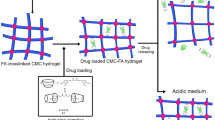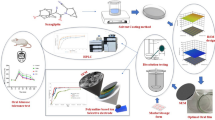Abstract
In the present study, novel hydrogels were prepared through graft copolymerization of methyl methacrylate onto starch and hydroxypropylated starch for intestinal drug delivery. The successful grafting has been confirmed by FTIR, NMR spectroscopy, and elemental analysis. Morphological examination of copolymeric hydrogels by scanning electron microscopy (SEM) confirms the macroporous nature of the copolymers. The high decomposition temperature was observed in thermograms indicating the thermal stability of the hydrogels. To attain a hydrogel with maximum percent graft yield, the impact of reaction variables like concentration of ceric ammonium nitrate as initiator and methyl methacrylate as monomer were consistently optimized. X-ray powder diffraction and differential scanning calorimetric analysis supported the successful entrapment of the drug moiety (esomeprazole magnesium; proton pump inhibitor) within the hydrogel network. Drug encapsulation efficiency of optimized hydrogels was found to be >78 %. Furthermore, swelling capacity of copolymeric hydrogels exhibited a pH-responsive behavior which makes the synthesized hydrogels potential candidates for controlled delivery of medicinal agents. In vitro drug release was found to be sustained up to 14 h with 80–90 % drug release in pH 6.8 solution; however, the cumulative release was 40–45 % in pH 1.2. The gastrointestinal transit behavior of optimized hydrogel was determined by gamma scintigraphy, using 99mTc as marker. The amount of radioactive tracer released from the labeled hydrogel was minimal when the hydrogel was in the stomach, whereas it increased as hydrogel reached in intestine. Well-correlated results of in vitro and in vivo analysis proved their controlled release behavior with preferential delivery into alkaline pH environment.











Similar content being viewed by others
References
Khurma JR, Nand AV. Temperature and pH sensitive hydrogels composed of chitosan and poly(ethylene glycol). Polym Bull. 2008;59(6):805–12.
Kunal P, Banthia AK, Majumdar DK. Starch based hydrogel with potential biomedical application as artificial skin. Afr J Biomed Res. 2006;9:23–9.
Janarthanan P, Yunus WMDZW, Ahmad MB. Thermal behavior and surface morphology studies on polystyrene grafted sago starch. J Appl Polym Sci. 2003;90:2053–8.
Han JA, Lee BH, Lim WJ, Lim ST. Utilization of hydroxypropylated waxy rice and corn starches in Korean waxy rice cake to retard retrogradation. Cereal Chem. 2005;82:88–92.
Shaikh MM, Lonikar SV. Starch–acrylics graft copolymers and blends: synthesis, characterization, and applications as matrix for drug delivery. J Appl Polym Sci. 2009;114:2893–900.
Johnson DA. Review of esomeprazole in the treatment of acid disorders. Expert Opin Pharmacother. 2003;4:253–64.
Kaur L, Singh N, Singh J. Factors influencing the properties of hydroxypropylated potato starches. Carbohydr Polym. 2004;55:211–23.
Lawal OS, Ogundiran OO, Awokoya K, Ogunkunle AO. The low-substituted propylene oxide etherified plantain (Musa paradisiacal normalis) starch: characterization and functional parameters. Carbohydr Polym. 2008;74:717–24.
Athawale VD, Lele V. Graft copolymerization onto starch. II. Grafting of acrylic acid and preparation of its hydrogels. Carbohydr Polym. 1998;35:21–7.
Wang Q, Zhang J, Wang A. Preparation and characterization of a novel pH-sensitive chitosan-g-poly (acrylic acid)/attapulgite/sodium alginate composite hydrogel bead for controlled release of diclofenac sodium. Carbohydr Polym. 2009;78:731–7.
Subhabrota M, Souvik R, Subhadeep C. Preparation and gamma scintigraphic evaluation of colon specific pellets of ketoprofen prepared by powder layering technology. DARU J Pharm Sci. 2011;19:47–56.
Shukla D, Chakraborty S, Mishra B. Evaluation of in-vivo behavior of controlled and pulsatile release pastilles using pharmacokinetic and γ-scintigraphic techniques. Expet Opin Drug Deliv. 2012;9:1333–45.
Tripathi R, Mishra B. Development and evaluation of sodium alginate–polyacrylamide graft–co-polymer based stomach targeted hydrogels of famotidine. AAPS PharmSciTech. 2012;13:1091–102.
Dias FF, Tekchandani HK, Mehta D. Modified starches and their use by food industries. Indian Food Ind. 1997;16:33–9.
Dias FF, Tekchandani HK, Mehta D. Modified starches and their use by food industries. Food Chem. 1997;64:361–75.
Xu A, Seib PA. Determination of the level and position of substitution in hydroxypropylated starch by high resolution 1H-NMR spectroscopy of alpha-limit dextrins. J Cereal Sci. 1997;25:17–26.
Casas M, Ferrero C, de Paz MV, Jiménez-Castellanos MR. Synthesis and characterization of new copolymers of ethyl methacrylate grafted on tapioca starch as novel excipients for direct compression matrix tablets. Eur Polym J. 2009;45:1765–76.
Singha AS, Rana AK. Kinetics of graft copolymerization of acrylic acid onto Cannabis indica fiber. Iran Polym J. 2011;20:913–29.
Goudanavar P, Reddy S, Hiremath D, Udupi R. Development and in-vitro characterization of esomeprazole floating gastro-retentive microspheres. J Appl Pharm Sci. 2013;3:71–7.
Sadeghi M, Hosseinzadeh H. Synthesis and properties of collagen-g-poly(sodium acrylate-co-2-hydroxy ethylacrylate) superabsorbent hydrogels. Braz J Chem Eng. 2013;30:379–89.
Acknowledgments
The authors are thankful to their parental institutes for providing the necessary facilities to accomplish the present research work. The authors are grateful to the Director, Spect Radiology Lab, Pune, and the nuclear medicine staff for their cooperation and for providing all the necessary facilities to conduct the gamma scintigraphy study.
Conflict of interest
The authors declared no conflict of interest.
Author information
Authors and Affiliations
Corresponding author
Electronic supplementary material
Below is the link to the electronic supplementary material.
ESM 1
(DOCX 2326 kb)
Rights and permissions
About this article
Cite this article
Kumar, P., Ganure, A.L., Subudhi, B.B. et al. Preparation and characterization of pH-sensitive methyl methacrylate-g-starch/hydroxypropylated starch hydrogels: in vitro and in vivo study on release of esomeprazole magnesium. Drug Deliv. and Transl. Res. 5, 243–256 (2015). https://doi.org/10.1007/s13346-015-0221-7
Published:
Issue Date:
DOI: https://doi.org/10.1007/s13346-015-0221-7




